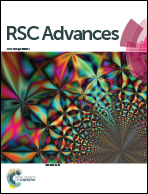Chelation as a strategy to reinforce cationic copper surface protection in acidic solutions†
Abstract
Industrial treatment (such as washing and rescaling) of copper-based equipment with acids requires the use of corrosion inhibitors to mitigate environmental pollution. However, the currently used organic inhibitors for copper, such as benzotriazole (BTA), are protonated in acidic solutions, thereby weakening the adsorption to a positively charged copper surface. Here we show that the use of an effective copper-ion chelator can overcome the repulsion between protonated inhibitors and a cationic copper surface in acidic solutions. With a variety of surface techniques including time of flight secondary ion mass spectrometry, X-ray photoelectron spectroscopy and X-ray diffraction, we determine that bis-triazolyl indoleamines (BTIs) can strongly coat onto a cationic copper surface in acidic solutions through chelation with Cu(I) species. The electrochemical techniques used suggest that the BTIs are much better corrosion inhibitors than BTA, showing consistently an outstanding inhibitive efficiency in spite of the reduction of the inhibitor concentration by 100-fold and the increase of solution temperature and acidic strength. A preliminary cell viability assay suggests that our BTI is much less toxic than BTA towards two healthy cell lines.


 Please wait while we load your content...
Please wait while we load your content...